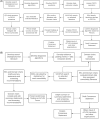ACVIM consensus statement on the diagnosis of immune thrombocytopenia in dogs and cats
- PMID: 38752421
- PMCID: PMC11256148
- DOI: 10.1111/jvim.16996
ACVIM consensus statement on the diagnosis of immune thrombocytopenia in dogs and cats
Abstract
Immune thrombocytopenia (ITP) is the most common acquired primary hemostatic disorder in dogs. Immune thrombocytopenia less commonly affects cats but is an important cause of mortality and treatment-associated morbidity in both species. Immune thrombocytopenia remains a diagnosis of exclusion for which diagnostic guidelines are lacking. Primary, or non-associative, ITP refers to autoimmune platelet destruction. Secondary, or associative, ITP arises in response to an underlying disease trigger. However, evidence for which comorbidities serve as ITP triggers has not been systematically evaluated. To identify key diagnostic steps for ITP and important comorbidities associated with secondary ITP, we developed 12 Population Evaluation/Exposure Comparison Outcome (PECO) format questions. These questions were addressed by evidence evaluators utilizing a literature pool of 287 articles identified by the panelists using a structured search strategy. Evidence evaluators, using panel-designed templates and data extraction tools, summarized evidence and created guideline recommendations that then were integrated by diagnosis and comorbidity domain chairs. The revised PECO responses underwent a Delphi survey process to reach consensus on final guidelines. A combination of panel expertise and PECO responses were employed to develop algorithms for diagnosis of ITP in dogs and cats, which also underwent 4 iterations of Delphi review. Comorbidity evidence evaluators employed an integrated measure of evidence (IME) tool to determine evidence quality for each comorbidity; IME values combined with evidence summaries for each comorbidity were integrated to develop ITP screening recommendations, which also were subjected to Delphi review. Commentary was solicited from multiple relevant professional organizations before finalizing the consensus. The final consensus statement provides clinical guidelines for the diagnosis of, and underlying disease screening for, ITP in dogs and cats. The systematic consensus process identified numerous knowledge gaps that should guide future studies. This statement is a companion manuscript to the ACVIM Consensus Statement on the Treatment of Immune Thrombocytopenia.
Keywords: autoimmune; hemostasis; immune‐mediated; platelet; thrombopoietin.
© 2024 The Authors. Journal of Veterinary Internal Medicine published by Wiley Periodicals LLC on behalf of American College of Veterinary Internal Medicine.
Conflict of interest statement
Dana LeVine has received relevant research funding from the American Kennel Club Canine Health Fund, BodeVet, Morris Animal Foundation, and Veterinary and Comparative Clinical Immunology Society (VCCIS) and honoraria for speaking engagements from the ACVIM Forum, ECVIM‐CA Congress, ACVIM Advanced Continuing Education, CVMA, and ACVP/ACSVP, and CanWest, and is also a consultant for Cellphire Therapeutics; Linda Kidd was a Veterinary Field Specialist for Zoetis Diagnostics August 2022‐July 2023, is an Associate Editor for the Journal of Veterinary Internal Medicine and has received speaking honoraria from the ACVIM and IDEXX; OIiver Garden has received relevant research funding from the Kennel Club (UK) and Okava Pharmaceuticals, and speaking honoraria from the ACVIM Forum, ECVIM‐CA Congress, and ACVP/ACSVP Annual Meeting. He has served as a consultant for Okava Pharmaceuticals and is the President of the Veterinary & Comparative Clinical Immunology Society; Marjory Brooks has received relevant research funding from the American Kennel Club and honoraria for speaking engagements from ACVIM Advanced Continuing Education, University of North Carolina Chapel Hill Symposium of Hemostasis, and the Society of Toxicologic Pathology's Symposium; Robert Goggs has received relevant research funding from the American Kennel Club Canine Health Fund, Aurin Biotech, BodeVet, Morris Animal Foundation, and Okava Pharmaceuticals and honoraria for speaking engagements from ACVIM Forum, EVECC Congress, IVECCS, PacVet, UnisVet and VCCIS; Julie Allen has served as a member of the Zoetis IMAGYST advisory board since 2022; Austin Viall has received relevant research funding from Morris Animal Foundation and VCCIS and has received honoraria for speaking engagements at ECVIM‐CA Congress, CanWest, CVMA, IVMA, and SDVMA; Erin Lashnits is a key opinion leader and research collaborator with IDEXX and Elanco Animal Health and research collaborator with Galaxy Diagnostics; Andrew Hanzlicek is an employee of MiraVista Diagnostics; Xavier Roura consults with Elanco, Idexx, Hill's, Purina, Affinity, Zoetis, Royal Canin, Merck Sharp and Dohme, Leti, Dechra, Bioiberica, Pharmacross, Nano1Health, Vetgenomics, Ecuphar, SantéVet, Fatro, Virbac, and Boehringer Ingelheim; Barbara Kohn has held lectures, had research collaborations and acted as a consultant for veterinary pharmaceutical and diagnostic companies. No other authors declare a conflict of interest.
Figures






References
-
- LeVine DN, Brooks MB. Immune thrombocytopenia (ITP): pathophysiology update and diagnostic dilemmas. Vet Clin Pathol. 2019;48(Suppl 1):17‐28. - PubMed
-
- Lewis DC, Meyers KM. Canine idiopathic thrombocytopenic purpura. J Vet Intern Med. 1996;10:207‐218. - PubMed
-
- Putsche JC, Kohn B. Primary immune‐mediated thrombocytopenia in 30 dogs (1997‐2003). J Am Anim Hosp Assoc. 2008;44:250‐257. - PubMed
-
- Wondratschek C, Weingart C, Kohn B. Primary immune‐mediated thrombocytopenia in cats. J Am Anim Hosp Assoc. 2010;46:12‐19. - PubMed
Publication types
MeSH terms
Grants and funding
LinkOut - more resources
Full Text Sources
Miscellaneous

